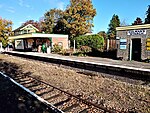Badley Moor
Sites of Special Scientific Interest in NorfolkSpecial Areas of Conservation in England

Badley Moor is an 18.3-hectare (45-acre) biological Site of Special Scientific Interest east of Dereham in Norfolk. It is part of the Norfolk Valley Fens Special Area of Conservation.This area of spring fed fen and grassland in the valley of the River Tud has tufa hummocks formed by the deposit of calcium carbonate. It has an exceptionally rich fen community with a carpet of moss on wet slopes with many unusual plants. There are overgrown dykes with flora including narrow-leaved water-parsnip and water dropwort.There is access by a short track from Dumpling Green.
Excerpt from the Wikipedia article Badley Moor (License: CC BY-SA 3.0, Authors, Images).Badley Moor
Cutthroat Lane, Breckland District
Geographical coordinates (GPS) Address Nearby Places Show on map
Geographical coordinates (GPS)
| Latitude | Longitude |
|---|---|
| N 52.666 ° | E 0.974 ° |
Address
Cutthroat Lane
NR19 1RG Breckland District
England, United Kingdom
Open on Google Maps








